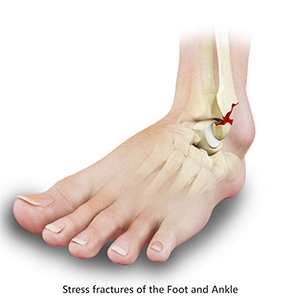You’re running down the pathway, enjoying the crisp air of the early spring morning. Your lungs expand easily with the refreshing air. Your feet pound the pavement in perfect rhythm, and you are in the zone.
But then you feel that sharp prick of pain on the top of your foot that seems to occur more and more regularly these days during your runs. You’ve tried to shake it off before, as if it were just a bruise or your running shoes that you need to replace, but the pain persists.
Do You Have a Stress Fracture?
If you are feeling a pinpoint jab of pain in your lower leg or the top of your foot, you could very likely be experiencing the effects of a stress fracture. It can go unnoticed for an extended period of time because the pain only rears its ugly head when you are in the middle of an activity that puts stress on that bone, such as running, gymnastics, tennis or basketball.
The only real way to tell if you have a stress fracture is to take a trip to the doctor for either an x-ray that would show if there is a crack in the bone. Oftentimes, however, x-rays can’t even pick up on the crack, which means you may need to get a MRI from an orthopedic surgeon.
How to Avoid Stress Fractures
According to the American Academy of Orthopaedic Surgeons, there are ways to reduce your chance of getting stress fractures as you train.
- Set incremental goals as you begin a new sports activity or exercise regimen. Don’t try to add too much mileage too fast.
- Cross-train. Alternating activities can help to prevent stress fractures. For instance, instead of running every day to meet cardiovascular goals, run on even days and bike on odd days. Add some strength training and flexibility exercises to the mix for the most benefit.
- Maintain a healthy diet. Be sure you have plenty of calcium and vitamin D-rich foods in your meals.
- Use the proper equipment. Throw out those old running shoes, and get new ones. Your body will thank you. See our blog on running shoes.
- Stop and rest if you experience sharp pain or swelling. Continuing the activity will make it worse. If the pain continues, see an orthopedic physician.
Unfortunately for avid runners, the most important treatment for a stress fracture is rest. That means no running for six to eight weeks until the bone heals. The impatient among us may inflict larger, harder to heal stress fractures that may cause irreparable damage to bone.
It’s important to remember, though, that the goal is to get back to your sport at your normal level as quickly as possible. Learn the symptoms early and treat them appropriately, and get back to doing what you love!
Happy and Safe Training!
Dr. Johnson






